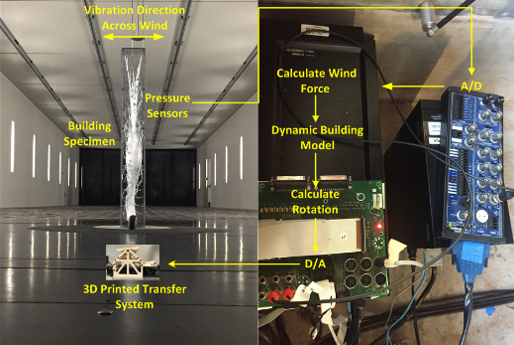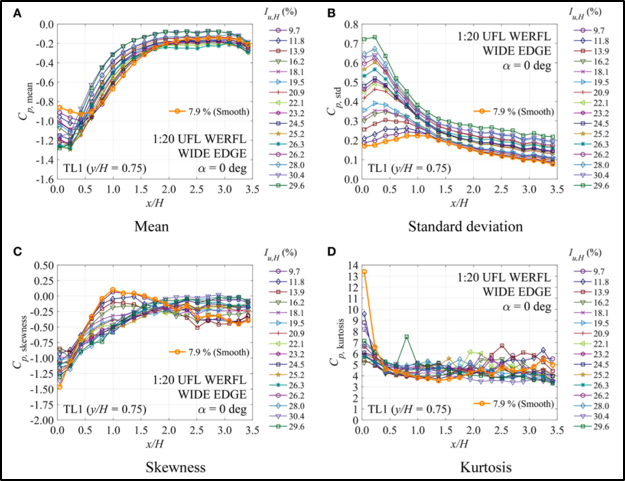Project Objective:
Team Members:
Key Achievements:
Broader Impacts:

Figure 1. Diagram of cyber-physical framework for optimal design under wind loading

Figure 2. Low-rise building model with controllable parapet wall.

Figure 3. Aeroelastic model under development
Project Objective:
Team Members:
Key Achievements:
Broader Impacts:

Figure 4. Calculated wind forces on the building model during vortex induced vibration

Figure 5. Sensing and control loop for the aeroelastic building model in the wind tunnel
Project Objective:
Team Members:
Key Achievements:
Broader Impacts:


Fernández-Cabán PL and Masters FJ (2018) Effects of Freestream Turbulence on the Pressure Acting on a Low-Rise Building Roof in the Separated Flow Region. Front. Built Environ. 4:17. doi: 10.3389/fbuil.2018.00017
Researchers at the University of Maryland and University of Florida are collaborating on a project to deliver a cyber-physical systems (CPS) approach to the optimal design of wind-sensitive structures. The approach combines the accuracy of physical wind tunnel testing with the efficient exploration of a solution space using numerical optimization algorithms. The approach is fully automated, with experiments executed in a boundary layer wind tunnel (BLWT), sensor feedback monitored by a high-performance computer (HPC), and optimization techniques used to bring about physical changes in the BLWT. Anticipated outcomes include: (1) the combination of high-fidelity experimental testing and numerically-driven optimization for wind engineering, (2) the advancement of optimization in a practical engineering setting, and (3) the discovery of new design and detailing features to achieve cost-effective structures.
Initial studies focus on a low-rise structure with parapet wall of variable height, adjusted at the model-scale using servo-motors. Parapets are common on industrial and commercial buildings and have a non-monotonic influence on a structures wind load. The model surface is instrumented with pressure taps to measure the envelope pressure. Design objectives include the mitigation of extreme roof loading and the creation of an efficient structural system. Implications of this proof-of-concept are significant for more complex structures where the optimal solution cannot be reasonably determined with traditional experimental or computational methods.
This project is funded by NSF under Grant No. 1636039 and uses the BLWT and HPC resources of the University of Florida NHERI Site under NSF Grant No. 1520843. This project is led by PI Asst. Prof. Brian Phillips of the University of Maryland and co-PI Prof. Forrest Masters of the University of Florida. For more information on the PIs research, please email brian.phillips@essie.ufl.edu.

University of Florida wind engineering class visits with researchers in the BLWT


Roof Suction
blue = high suction; red = low suction


Roof Suction
blue = high suction; red = low suction
BLWT model with a 1 inch parapet wall, 45° approach wind angle, and a qualitative distribution of extreme roof suction
| NSF Award Number | Award Start Date | Award End Date | Investigator(s)/Institutuion | Title | Status | Data Published | Publication |
| 2037725 | 1/1/2016 | 10/30/2025 | Jennifer Bridge/University of Florida | Natural Hazards Engineering Research Infrastructure: Experimental Facility with Boundary Layer Wind Tunnel | Ongoing | Publication Link | |
| 2340755 | 4/1/2024 | 3/31/2029 | Marco Giometto/Columbia University | CAREER: Characterization of Turbulence in Urban Environments for Wind Hazard Mitigation | Ongoing | ||
| 2339437 | 2/1/2024 | 1/31/2029 | Pedro Fernandez-Caban/Florida State University, Florida Agricultural and Mechanical University | CAREER: Fusing Meta-Learning Systems and Field Observations to Enhance the Simulation of Extreme Winds and their Impact on Civil Infrastructure | Ongoing | ||
| 2302650 | 7/1/2023 | 6/23/2025 | Catherine Gorle/Stanford University | EAGER: Advanced Digital Twin Capability for Turbulent Wind Fields in the NHERI Boundary Layer Wind Tunnel at the University of Florida | Complete | ||
| 2327346 | 1/1/2024 | 12/31/2025 | Luis Zambrano-Cruzatty/University of Maine | RII Track-4:NSF: From the Ground Up to the Air Above Coastal Dunes: How Groundwater and Evapotranspiration Affect the Mechanism of Wind Erosion | Ongoing | ||
| 1749610 | 7/1/2018 | 6/30/2023 | Catherine Gorle/Stanford University | CAREER: Quantifying Wind Hazards on Buildings in Urban Environments | Complete | ||
| 2215297 | 8/15/2022 | 7/31/2025 | Brian Phillips, Forrest Masters/University of Florida | MRI-Sentinel | Complete | ||
| 2131961 | 2/1/2022 | 1/31/2026 | Arindam Chowdhury/Florida International University | MsRI: National Full-Scale Testing Infrastructure for Community Hardening in Extreme Wind, Surge, and Wave Events (NICHE) | Complete | ||
| 2153762 | 7/1/2022 | 6/30/2025 | Kurtis Gurley/University of Florida | Collaborative Research: Enabling Damage Reduction and Improved Urban Community Resilience through Data-and-Physics-Integrated Windborne Debris Modeling | Complete | ||
| 2153751 | 7/1/2022 | 6/30/2025 | Yanlin Guo, John van de Lindt/Colorado State University | Collaborative Research: Enabling Damage Reduction and Improved Urban Community Resilience through Data-and-Physics-Integrated Windborne Debris Modeling | Complete | ||
| 2144760 | 5/1/2022 | 4/30/2027 | Franklin Lombardo/University of Illinois at Urbana-Champaign | CAREER: Engineering-Centric Thunderstorm Hazard and Loading Characterization | Ongoing | ||
| 2138414 | 1/1/2022 | 12/31/2023 | Pedro Fernandez-Caban/Clarkson University | ERI: Physical Simulation of Terrain-Induced and Large-Scale Turbulence Effects on the Effectiveness of Wind Mitigation Strategies for Low-Rise Buildings | Complete | Data | |
| 2046001 | 9/15/2021 | 8/31/2026 | Erica Fischer/Oregon State University | CAREER: Innovative Technology for Mass Timber and Hybrid Modular Buildings | |||
| 2028762 | 1/1/2021 | 12/31/2023 | Brian Phillips/University of Florida | Collaborative Research: Aerodynamic shape optimization of tall buildings using automated cyber-physical testing | Complete | Publication Link | |
| 2028647 | 1/1/2021 | 12/31/2023 | Jiang Zhaoshuo/San Fransisco State University | Collaborative Research: Aerodynamic shape optimization of tall buildings using automated cyber-physical testing | Complete | Publication Link | |
| 1856205 | 8/15/2019 | 7/31/2022 | Sungmoon Jung/Florida State Unviersity | Effect of Heterogeneous Terrain on Wind Loads on Building | Complete | Data | |
| 1930625 | 9/1/2019 | 8/31/2024 | Kurt Gurley/University of Florida | Collaborative Research: Wind tunnel modeling of higher-order turbulence and its effects on structural loads and response | Complete | ||
| 1930389 | 9/1/2019 | 8/31/2024 | Michael Sheilds/Johns Hopkins University | Collaborative Research: Wind tunnel modeling of higher-order turbulence and its effects on structural loads and response | Complete | ||
| 1663947 | 8/1/2017 | 7/31/2020 | David Nolan/University of Miami | PREEVENTS Track 2: Collaborative Research: More resilient coastal cities and better hurricane forecasts through multi-scale modeling of extreme winds in the urban canopy | Complete | ||
| 1841979 | 8/15/2015 | 7/31/2020 | Forrest Masters/University of Florida | EAGER: Exploring Machine Learning and Atmospheric Simulation to Understand the Role of Geomorphic Complexity in Enhancing Civil Infrastructure Damage during Extreme Wind Events | Complete | Data1 | Publication Link |
| 1750339 | 9/1/2018 | 8/31/2023 | Seymour Spence/University of Michigan | CAREER: Using Metamodeling to Enable High-Fidelity Modeling in Risk-based Multi-hazard Structural Design | Complete | ||
| 1562244 | 6/1/2015 | 5/31/2018 | Ahsan Kareem/University of Notre Dame | Collaborative Research: Performance-Based Framework for Wind-Excited Multi-Story Buildings | Complete | ||
| 1462084 | 6/1/2015 | 5/31/2018 | Seymour Spence/University Michigan | Collaborative Research: Performance-Based Framework for Wind-Excited Multi-Story Buildings | Complete | ||
| 1663363 | 5/1/2017 | 4/30/2020 | Delong Zuo/Texas Tech University | Benchmark Study of Tornado Wind Loading on Low-Rise Buildings with Consideration of Internal Pressure | Complete | Data | |
| 1732223 | 6/15/2017 | 5/31/2019 | Steve Wojtkiewicz/Clarkson University | EAGER/Collaborative Research: Aeroelastic Real-Time Hybrid Simulation for Wind Engineering Experimentation | Complete | Data | |
| 1732213 | 6/15/2017 | 5/31/2019 | Richard Christenson/University of Connecticut | EAGER/Collaborative Research: Aeroelastic Real-Time Hybrid Simulation for Wind Engineering Experimentation | Complete | Data | |
| 1636039 | 8/1/2016 | 7/31/2019 | Brian Phillips/University of Maryland | Cyber-physical systems approach to the optimal design of structures for wind hazards | Complete | 1st Publication Link | |
| 2nd Publication Link | |||||||
| 1428954 | 9/1/2014 | 4/30/2019 | Forrest Masters/University of Florida | MRI: Development of a Versatile, Self-Configuring Turbulent Flow Condition System for a Shared-Use Hybrid Low-Speed Wind Tunnel | Complete | Data | Publication Link |
| 1055744 | 3/1/2011 | 9/30/2018 | Forrest Masters/University of Florida | CAREER: Behavior of Hurricane Wind and Wind-Driven Rain in the Coastal Suburban Roughness Sublayer | Complete | 1st Publication Link | |
| 2nd Publication Link | |||||||
| 3rd Publication Link | |||||||
| 4th Publication Link | |||||||
| 1328930 | 9/15/2013 | 8/31/2018 | Sanjiv Singh, Burcu Akinci, Daniel Huber, Sebastian Scherer/Carnegie Mellon University | Collaborative Research: Fast and Accurate Infrastructure Modeling and Inspection with Low-Flying Robots | Complete | Publication Link | |
| 1463497 | 6/1/2015 | 5/31/2018 | Jim Ricles/Lehigh University | Collaborative Research: Semi-Active Controlled Cladding Panels for Multi-Hazard Resilient Buildings | Complete | ||
| 1265511 | 6/1/2013 | 5/31/2018 | Mircea Grigoriu/Cornell University | Performance-based Multi-Hazard Engineering for Seismic and Wind Loads | Complete | Publication Link | |
| Non-NSF Agency | Award Start Date | Award End Date | Investigator(s) | Title | Status | ||
| NIST | 2019 | 2021 | Brian Phillips/University of Florida | Complete | |||
| NOOA | 2019 | 2021 | Kurt Gurley, Steve Miller/University of Florida | Sound testing with Microphone Instrumentation in the BLWT | Complete | ||
| PGT | 2019 | 2019 | Industry | Behavior of Wind-Driven Rain against Windows and Doors for standards evaluation. | Complete | ||
| FEMA | 2019 | 2019 | Forrest Masters/University of Florida | Wind Tunnel Testing and Field Measurement of Winds for the NCST Investigation of Hurricane Marias Impacts on Puerto Rico | Complete | ||
| FEMA | 2019 | 2019 | Luis Aponte/University of Puerto Rico | Wind Tunnel Testing and Field Measurement of Winds for the NCST Investigation of Hurricane Marias Impacts on Puerto Rico | Complete | ||
| FDOT | 2016 | 2017 | Jennifer Bridge/University of Florida | FDOT Mast Arm Project | Complete | ||
| FDOT | 2024 | 2025 | Jennifer Bridge/University of Florida | Light Poles | Ongoing | ||
| USDA | 2025 | 2025 | Tree Study | Ongoing |